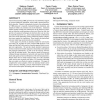Free Online Productivity Tools
i2Speak
i2Symbol
i2OCR
iTex2Img
iWeb2Print
iWeb2Shot
i2Type
iPdf2Split
iPdf2Merge
i2Bopomofo
i2Arabic
i2Style
i2Image
i2PDF
iLatex2Rtf
Sci2ools
DEBS
2007
ACM
2007
ACM
Modeling the communication costs of content-based routing: the case of subscription forwarding
Content-based routing (CBR) provides the core distribution support of several middleware paradigms, most notably content-based publish-subscribe. Despite its popularity, however, the performance of CBR protocols is typically evaluated through simulation, and analytical models are extremely rare in the literature. Analytical models capture formally the characteristic of the analyzed system, and are therefore worth pursuing on their own. However, they also provide very practical advantages in that they allow one to evaluate tradeoffs extensively (i.e., across many parameter combinations and across all the interesting values) without the lengthy computation times required by simulations. These benefits are particularly welcome when large-scale networks are considered. In this paper, we provide an analytical model for subscription forwarding [4], arguably the most common CBR protocol in use today and one that is often used as a baseline against which to compare new approaches. We provide ...
Analytical Model | Analytical Models Capture | Cbr Protocol | DEBS 2007 | Distributed And Parallel Computing |
| Added | 14 Aug 2010 |
| Updated | 14 Aug 2010 |
| Type | Conference |
| Year | 2007 |
| Where | DEBS |
| Authors | Stefano Castelli, Paolo Costa, Gian Pietro Picco |
Comments (0)

